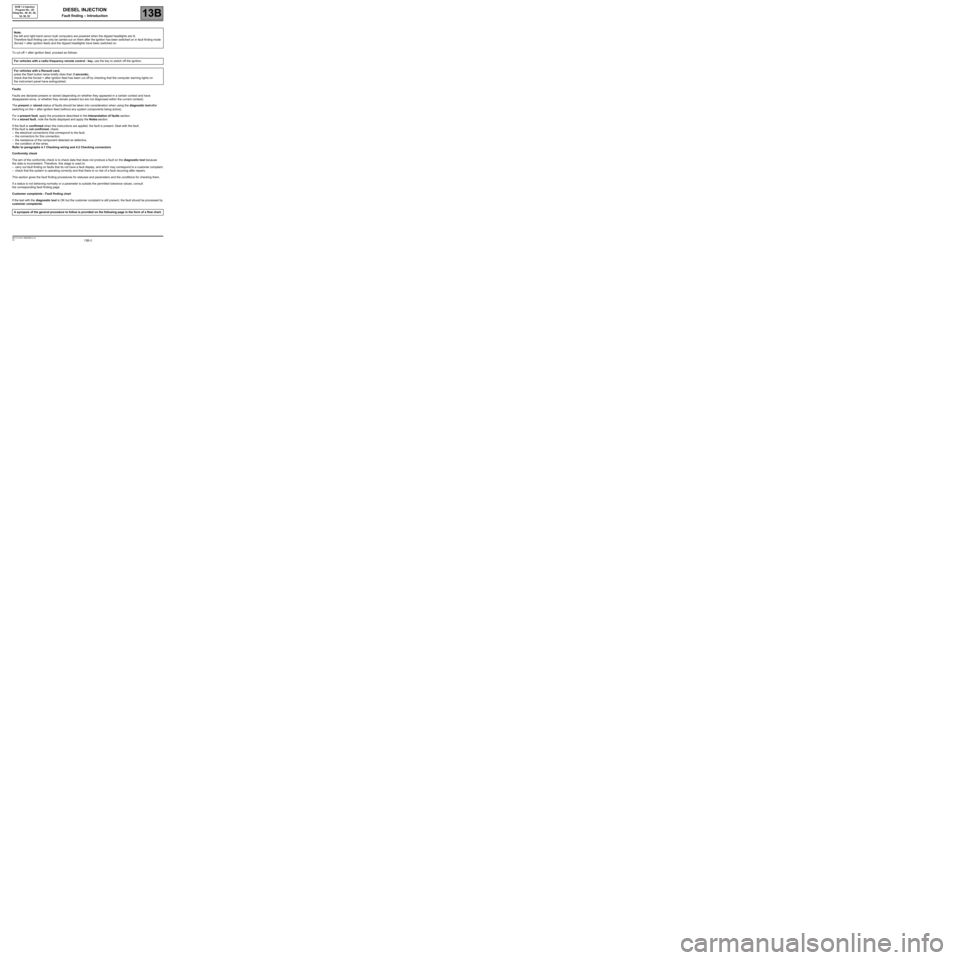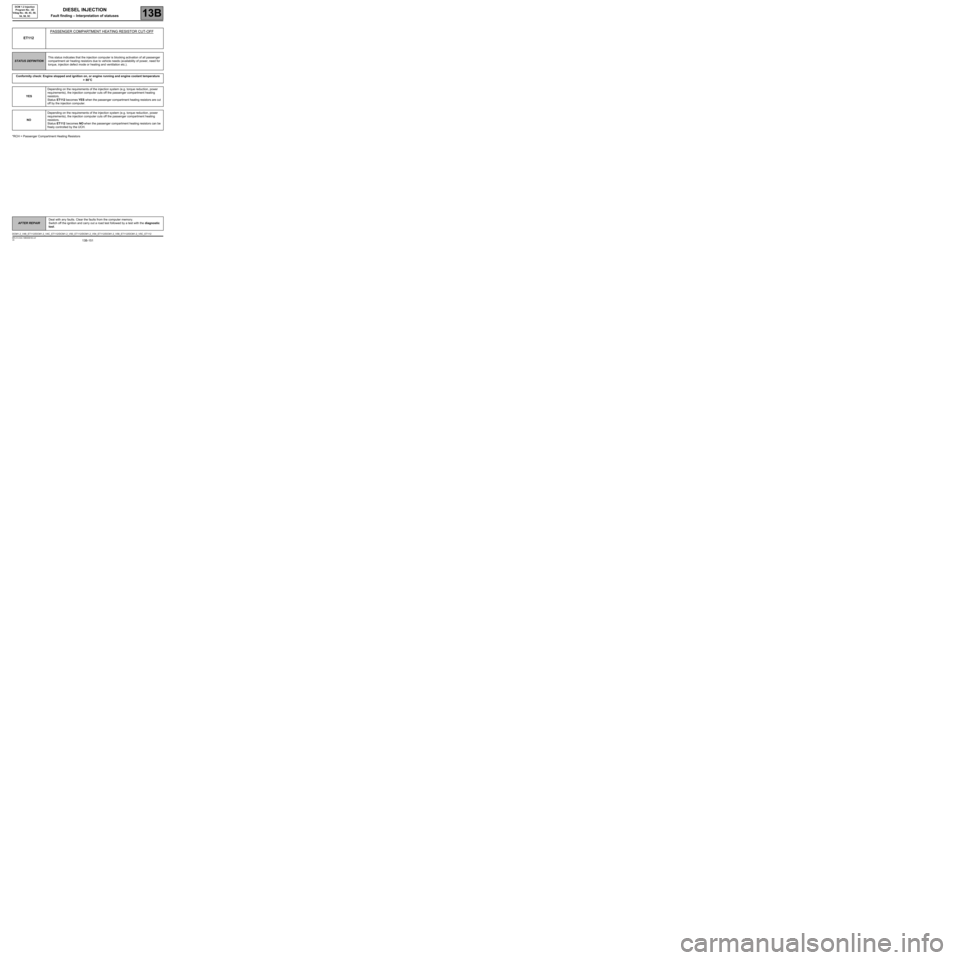ECO mode RENAULT TWINGO 2009 2.G Engine Diesel Injection Workshop Manual
[x] Cancel search | Manufacturer: RENAULT, Model Year: 2009, Model line: TWINGO, Model: RENAULT TWINGO 2009 2.GPages: 269
Page 3 of 269

13B-3V6 MR-413-X44-13B000$010.mif
DIESEL INJECTION
Fault finding – Introduction13B
DCM 1.2 Injection
Program No.: 4D
Vdiag No.: 48, 4C, 50,
54, 58, 5C
To cut off + after ignition feed, proceed as follows:
Faults
Faults are declared present or stored (depending on whether they appeared in a certain context and have
disappeared since, or whether they remain present but are not diagnosed within the current context).
The present or stored status of faults should be taken into consideration when using the diagnostic tool after
switching on the + after ignition feed (without any system components being active).
For a present fault, apply the procedure described in the Interpretation of faults section.
For a stored fault, note the faults displayed and apply the Notes section.
If the fault is confirmed when the instructions are applied, the fault is present. Deal with the fault.
If the fault is not confirmed, check:
–the electrical connections that correspond to the fault,
–the connectors for this connection,
–the resistance of the component detected as defective,
–the condition of the wires.
Refer to paragraphs 4.1 Checking wiring and 4.2 Checking connectors
Conformity check
The aim of the conformity check is to check data that does not produce a fault on the diagnostic tool because
the data is inconsistent. Therefore, this stage is used to:
–carry out fault finding on faults that do not have a fault display, and which may correspond to a customer complaint.
–check that the system is operating correctly and that there is no risk of a fault recurring after repairs.
This section gives the fault finding procedures for statuses and parameters and the conditions for checking them.
If a status is not behaving normally or a parameter is outside the permitted tolerance values, consult
the corresponding fault finding page.
Customer complaints - Fault finding chart
If the test with the diagnostic tool is OK but the customer complaint is still present, the fault should be processed by
customer complaints. Note:
the left and right-hand xenon bulb computers are powered when the dipped headlights are lit.
Therefore fault finding can only be carried out on them after the ignition has been switched on in fault finding mode
(forced + after ignition feed) and the dipped headlights have been switched on.
For vehicles with a radio frequency remote control - key, use the key to switch off the ignition.
For vehicles with a Renault card,
press the Start button twice briefly (less than 3 seconds),
check that the forced + after ignition feed has been cut off by checking that the computer warning lights on
the instrument panel have extinguished.
A synopsis of the general procedure to follow is provided on the following page in the form of a flow chart.
Page 128 of 269

13B-128
AFTER REPAIRCarry out another fault finding check on the system.
Deal with any other faults.
Clear the stored faults.
V6 MR-413-X44-13B000$150.mif
DIESEL INJECTION
Fault finding – Interpretation of statuses13B
DCM 1.2 Injection
Program No.: 4D
Vdiag No.: 48, 4C, 50,
54, 58, 5C
ET003ENGINE IMMOBILISER
STATUS DEFINITIONACTIVE: This status indicates that the immobiliser is active.
INACTIVE: This status indicates that the immobiliser is inactive.
NOTESACTIVE: ET003 "ENGINE IMMOBILISER" shows the vehicle protection status.
This Verlog 4 type immobiliser function is managed by the UCH computer and the
injection computer.
Before any starting request, the computer is protected.
When a starting request is made, the injection computer and the UCH exchange
authentication data via the multiplex network. This determines whether the engine start
is authorised or denied.
After more than 5 consecutive failed authentication attempts, the injection computer
goes into protection (anti-scanning) mode and no longer tries to authenticate the UCH
computer.
It only leaves this mode when the following sequence of operations is carried out:
–The ignition is left on for at least 5 seconds,
–The ignition is switched off,
–The injection computer self-supply cuts out when it should (the time varies according
to engine coolant temperature).
Conformity check: Engine stopped, ignition on or engine running.
"ACTIVE"If status ET003 is ACTIVE see 82A, Engine immobiliser.
"INACTIVE"When the ignition is switched on and when driving, status ET003 should be INACTIVE,
if this is not the case, see 82A, Engine immobiliser.
DCM1.2_V48_ET003/DCM1.2_V4C_ET003/DCM1.2_V50_ET003/DCM1.2_V54_ET003/DCM1.2_V58_ET003/DCM1.2_V5C_ET003
Page 151 of 269

13B-151
AFTER REPAIRDeal with any faults. Clear the faults from the computer memory.
Switch off the ignition and carry out a road test followed by a test with the diagnostic
tool.
V6 MR-413-X44-13B000$150.mif
DIESEL INJECTION
Fault finding – Interpretation of statuses13B
DCM 1.2 Injection
Program No.: 4D
Vdiag No.: 48, 4C, 50,
54, 58, 5C
*RCH = Passenger Compartment Heating Resistors
ET112PASSENGER COMPARTMENT HEATING RESISTOR CUT-OFF
STATUS DEFINITIONThis status indicates that the injection computer is blocking activation of all passenger
compartment air heating resistors due to vehicle needs (availability of power, need for
torque, injection defect mode or heating and ventilation etc.).
Conformity check: Engine stopped and ignition on, or engine running and engine coolant temperature
> 80
°C
YESDepending on the requirements of the injection system (e.g. torque reduction, power
requirements), the injection computer cuts off the passenger compartment heating
resistors.
Status ET112 becomes YES when the passenger compartment heating resistors are cut
off by the injection computer.
NODepending on the requirements of the injection system (e.g. torque reduction, power
requirements), the injection computer cuts off the passenger compartment heating
resistors.
Status ET112 becomes NO when the passenger compartment heating resistors can be
freely controlled by the UCH.
DCM1.2_V48_ET112/DCM1.2_V4C_ET112/DCM1.2_V50_ET112/DCM1.2_V54_ET112/DCM1.2_V58_ET112/DCM1.2_V5C_ET112
Page 158 of 269

13B-158
AFTER REPAIRDeal with any faults. Clear the faults from the computer memory.
Switch off the ignition and carry out a road test followed by a test with the diagnostic
tool.
V6 MR-413-X44-13B000$150.mif
DIESEL INJECTION
Fault finding – Interpretation of statuses13B
DCM 1.2 Injection
Program No.: 4D
Vdiag No.: 48, 4C, 50,
54, 58, 5C
ET415
CONTINUED 4
STATUS 8Automatic gearbox in defect mode.
Status ET415 becomes STATUS 8 when driving with the cruise control active (ET042
Cruise control/speed limiter: CRUISE CONTROL) and the automatic gearbox is in
defect mode.
This signal is conveyed on the multiplex line and deactivates the cruise control.
Carry out a multiplex network test (see 88B, Multiplexing), then run fault finding on the
automatic gearbox computer.
Deal with any present or stored faults (see 23A, Automatic gearbox).
Clear the fault memory of the automatic gearbox computer by applying command RZ001
Fault memory.
Reinitialise status ET415 on the injection computer by running command RZ001
"Fault memory".
If the specification STATUS 8 is still present, contact Techline.
STATUS 9Vehicle speed monitoring
Status ET415 becomes STATUS 9 if the vehicle speed received by the computer is
invalid or absent.
This signal is conveyed on the multiplex line and deactivates the cruise control.
Test the multiplex network (see 88B, Multiplexing), then run fault finding on the ABS
computer.
Deal with any present or stored faults (see 38C, Anti-lock braking system).
Reinitialise status ET415 on the injection computer by running command RZ001
"Fault memory".
If the specification STATUS 9 is still present, contact Techline.